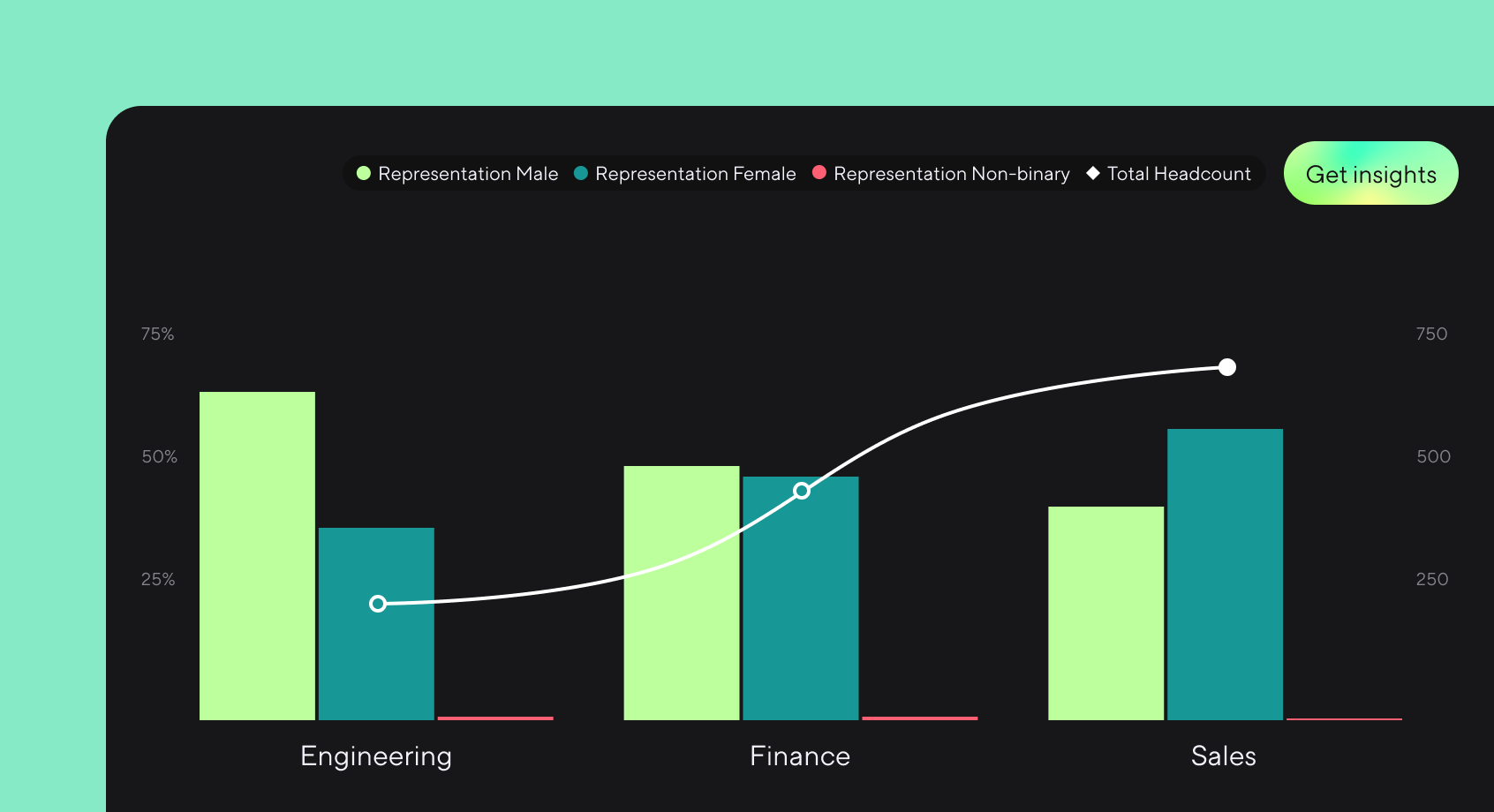Buyer's Guide: Choosing the right DEI software
Hallie Bregman, PhD – May 10th, 2023
There are lots of choices for DEI software—business intelligence, people analytics, or purpose-built solutions like Dandi. This article breaks down the pros and cons of each.

There is a longstanding debate about whether a generalist or specialist is best. Honestly, in most cases, it depends. It depends on the need, the level of expertise required, and the desired impact of the work.
The same thinking applies to technology.
In the DEI analytics space, there are multiple options: a general purpose business intelligence tool designed for any analytics, a people analytics tool, or a specialized DEI analytics tool with expertise in ethics, privacy, intersectionality, and more.
While there is no one size fits all approach, there are real pros and cons to each option. In this article, I'll take you through your choices.
Business intelligence (BI) tools
Pros: Endless possibilities; your company may already have a BI solution
Cons: Data configuration and maintenance can be heavy lifts; weak security protocols
Business intelligence tools offer incredible flexibility and customization of data. Data sources might come from marketing, operations, pricing, employees and more.
Within DEI, there are some real advantages here. For instance, if you want to bring data on supplier diversity together with data on employee diversity, you can. If you want to bring data on employer branding together with data on inclusion surveys, you can. The opportunities are endless.
Yet, there are severe limitations to these efforts. After all, when a tool has no bounds, it also has no specialization.
First, the data pipeline must be structured and maintained. This often means a large investment in creating data warehouses/data lakes, developing ETL processes, and accounting for data cleanliness. These efforts can be significant.
Unlike specialized tools familiar with DEI and people data, general business intelligence tools are not built with privacy in mind.
On top of formulating the data pipeline, you'll also have to create your dashboards and charts one by one. Again, a serious investment of resources is required.
This often requires a larger team to create the views, and then maintain them. If you have 50 dashboards, maintenance of these dashboards is time consuming. When data pipelines change, dashboards error out. When metric definitions change, dashboards must be updated. When end users change, dashboards must be amended. There are many scenarios where maintenance alone takes significant time.
Finally, perhaps the most major limitation is with regard to security and privacy.
Unlike specialized tools familiar with DEI and people data, general business intelligence tools are not built with privacy in mind. That’s not to say they can’t be configured; generally they can with appropriate encryption, firewalls, and permissions.
But these permissions are much less secure, much less flexible, and much less scalable. If the biggest risk in DEI analytics had to be named, it would be privacy. This is not a time to mess around.
People analytics tools
Pros: Central hub for people insights; easier to set up than BI tools
Cons: Often lack essential DEI features like intersectional measurement
Moving down the funnel of specificity are general people analytics tools. These are tools designed specifically to handle people data across the employee lifecycle. Generally, these tools are owned by People Analytics teams and utilized across the business.
General people analytics tools solve many of the pain points created by business intelligence tools.
They structure data pipelines, offer hundreds of out-of-the-box visualizations, and maintain charts in a robust fashion. In general, the human capital resource investment is significantly less than with a business intelligence tool.
Security and privacy are also usually handled in a more robust way. Typically, line item identification is obscured, and the focus is on aggregate analytics. Permissions can be scaled more easily. ETL is often handled by the software itself, and therefore secure. These are critical features to maintain confidentiality and protect privacy.
Analyses around pay equity, if present at all, are often missing important control factors.
One of the biggest benefits of a general people analytics tool is embedding DEI in all employee analytics. As a “one-stop-shop," it’s possible that more stakeholders will use the tool because they are already consuming other data points in it. When appropriate, getting stakeholders to utilize the analytics provided is critical, and this type of tooling can be instrumental in accomplishing that.
However, there are still limitations of general people analytics software. Without specified DEI knowledge, there are likely to be gaps in capabilities. For instance, analytics around intersectionality are typically not pre-configured. Analyses around pay equity, if present at all, are often missing important control factors.
Perhaps the biggest limitation is around regulatory requirements and risk. Without specialized expertise in regulations like pay transparency, GDPR, and ethical AI, there are some serious gaps. These gaps introduce risk.
Specialized DEI analytics tools
Pros: Core features purpose-built for DEI; address important privacy concerns
Cons: May be viewed as duplicative to other software the business already uses
Finally, there are specialized DEI analytics tools. These tools are your DEI experts. They support the nuance of DEI. They support the regulations in DEI. They reduce the risk when it comes to DEI. These benefits should not be overlooked.
First, unlike general people analytics tools, these tools can be implemented under legal privilege. In these scenarios, counsel aims to identify inequities in the organization in order to find solutions to reduce risk. Because these analyses may uncover bias, legal privilege protects this information from being discoverable by court.
This may sound questionable to employees—why would an organization need to protect these analyses? However, many organizations need to protect their assets and investors, and by doing this work under privilege, they gain the visibility needed to take action and work to rectify them.
Another huge value-add is around DEI storytelling. With the ability to create custom reports and visualizations, there’s a clear focused destination for all of your DEI insights. With these tools, the ability to leverage well-defined metrics with ease is key. No longer do your leaders need to request unique views for their organizations; instead, identified filters can be applied with the click of a button, showing leadership the gaps in their departments or focus areas. In fact, leadership can be granted the ability to self-serve, eliminating long delays due to manual efforts.
These tools also provide the capability to engage in ongoing, real-time gap analyses. Focus areas shift frequently, and having the data to support investments offers a real advantage. Seeing gaps in leadership progression? Use those insights to implement leadership programs. Seeing gaps in turnover? Implement detailed exit surveys to get more insight. You can make pivots in real-time, driven by the data.
With specialized DEI software, organizational risk is decreased significantly and insights are more accurate and actionable.
The ability to conduct pay equity analysis is another huge benefit of a DEI-specific tool. Historically outsourced to legal teams and conducted annually, this tooling automates the analysis and gives you insight on an ongoing basis. With constant changes due to hiring and turnover, annual analysis isn’t enough.
Then there is intersectionality. Too often, DEI work is limited to gender alone, or race/ethnicity alone. But, no one is a woman in silo, or a Black person in silo. They may be a Black woman in their 30’s, or a Hispanic male in their 50’s. These intersectional attributes must be embedded in all DEI analytics. Specialized tools, like Dandi, bring this to the front and center.
Finally, often, DEI specific tools provide benchmarks. Every organization I’ve ever worked with has asked for benchmarks. While there are pros and cons to using benchmarks, the ability to easily compare your organization to industry norms is meaningful. Using personalized, organization-specific metrics alongside industry benchmarks gives you a holistic view of your company's progress.
Conclusion
Ultimately there is no one-size-fits all solution. Each business has to look at their existing tech stack, and their DEI goals to make the appropriate choices for them.
However, if you're looking to streamline the work of DEI, purpose-built software like Dandi offers real advantages.
Organizational risk is decreased significantly. Insights are more accurate and applicable, with intersectionality at the forefront. There are support partners who are specialized in DEI who can guide you along the way. These benefits should not be taken lightly.
Want to learn more about Dandi? Book a demo with our team.
More from the blog
Announcing more powerful Dandi data visualizations
Team Dandi - Oct 23rd, 2024
The New Maturity Model for HR Data
Catherine Tansey - Sep 5th, 2024
Buyer’s Guide: AI for HR Data
Catherine Tansey - Jul 24th, 2024
Powerful people insights, 3X faster
Team Dandi - Jun 18th, 2024
Dandi Insights: In-Person vs. Remote
Catherine Tansey - Jun 10th, 2024
Introducing Dandi AI for HR Data
Team Dandi - May 22nd, 2024
5 essential talent and development dashboards
Catherine Tansey - May 1st, 2024
The people data compliance checklist
Catherine Tansey - Apr 17th, 2024
5 essential EX dashboards
Catherine Tansey - Apr 10th, 2024
Proven strategies for boosting engagement in self-ID campaigns
Catherine Tansey - Mar 27th, 2024









